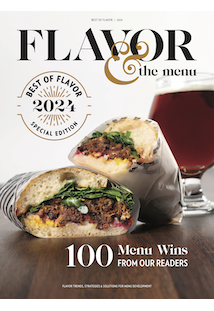

The French dip’s straightforward manual calls for sturdy bread, tender meat and savory jus. Of course, the global pantry is rich with inspiration to take it in different directions. Here are a few pathways to distinction, showcasing differentiation opportunities in the meat, the bread, the dip and the optional toppings.
While it’s exciting to seek out the next new sandwich, it’s important not to overlook the innovation opportunities offered by the classics. The French dip is one such icon worth a closer look, allowing operators to leverage its heartiness, comfort positioning, crave factor and familiarity while tinkering with its components for signature variations.
This sandwich has endured more than 100 years on American menus, and with good reason. It’s a straightforward meaty handheld served warm and built on a sturdy bread, like a French roll or baguette, with a side of savory broth that’s designed for dunking, allowing bites to soak up rich and juicy flavors.
Classic versions are typically served plain, though some traditional options include Swiss cheese and onions.
This American invention is said to have originated in Los Angeles, at either Cole’s Pacific Electric Buffet or Philippe the Original. Why and how it was created is also a bit of a culinary mystery. Tales range from a frugal patron requesting the roll be dipped in beef juices so as to limit waste to a sympathetic chef dipping the crusty roll in the broth to soften the sandwich for a guest with painful dental work. At Philippe’s, the sandwich continues to be dipped in juices in the kitchen and served “wet,” while Cole’s plates the beef broth as a side.
Modernizing the Classic
Whatever its origin, Americans have been enjoying the French dip for more than 100 years. And despite its rank as a classic, chefs continue to experiment with the original.
Stacked, a sandwich shop in Portland, Ore., demonstrates the opportunity around creative flavor development and the application of unique twists. Its Oxtail French Dip stars braised oxtail, cast iron-charred onions, cremini mushrooms and Havarti on a toasted hoagie with a side of rosemary au jus.
Denver’s modern American eatery Beast + Bottle follows a similar track, using the French dip as a platform for innovative flavor play. Its iteration, the Lamb Leg French Dip, features smoked chèvre, caramelized bacon and a side of rosemary lamb au jus. Neither of these variations strays too far from the promise of a French dip, but each delivers modern renditions that reflect their kitchens’ sensibilities.
In a sandwich world where diners clamor for trending handhelds like the banh mi, cemita and katsu sando, the French dip holds enduring appeal. According to Datassential, its draw is highest among Gen Xers and Boomers—two diner demographics often overlooked, but still carrying tremendous purchasing power. The French dip’s simplicity, part of its longstanding charm, makes this format a smart way to ease patrons into trying bolder or less familiar flavors.

Global Takes on the French Dip
The French dip’s straightforward manual calls for sturdy bread, tender meat and savory jus. Of course, the global pantry is rich with inspiration to take it in different directions. Here are a few pathways to distinction, showcasing differentiation opportunities in the meat, the bread, the dip and the optional toppings.
Mexican – Torta – Carnitas – Savory pork stock – (Pickled jalapeño)
Korean – French bread – Bulgogi beef – Gochujang broth – (Radish and cilantro)
Eastern Med – Thick Turkish flatbread – Herb-crusted lamb – Rosemary au jus with side of tahini dressing – (Feta and roasted onions with thyme)
Italian – Parmesan-crusted ciabatta – Shredded osso buco – Italian herb au jus – (Gremolata)







